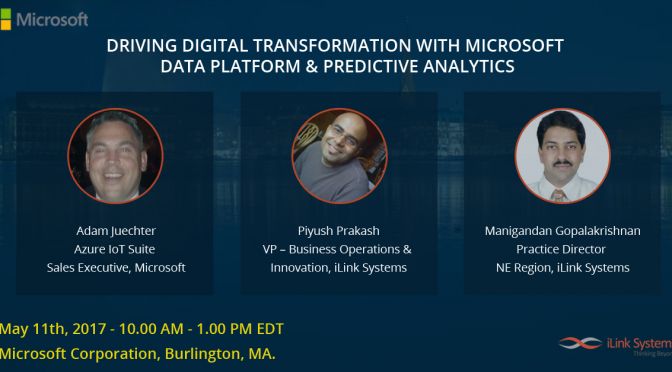
Microsoft and iLink to present a half-day event on “Driving Digital Transformation with Microsoft Data Platform, Predictive Analytics and IoT” in New York, NY
Redmond, WA Aug 28th, 2017: iLink Systems, an ISO and CMMI certified global software solutions provider, Microsoft Gold Level Partner and winner of several Microsoft “Partner of the Year” Awards, today announced an upcoming complimentary lunch event titled “Driving Digital Transformation with Microsoft Data Platform, Predictive Analytics and IoT” scheduled for Sep 15th , 2017 in New York, NY. The event is co-sponsored by Microsoft and will be held at Microsoft Office, New York, NY. One can register at https://www.ilink-systems.com/insights/ilink-events/driving-digital-transformation-microsoft-data-platform-predictive-analytics-iot-newyork/
Attend this event to learn from experienced practitioners, using real examples and deep dive session demonstrating how you can leverage SQL Server 2016 / Azure SQL DB & Cortana Intelligence Suite to unlock the true power of data in a most cost effective and secure way. We will not only review the science behind these offerings, but also review how they can add value to your various data analysis needs: geospatial, streaming, machine-generated, and unstructured text, to name a few.
The agenda for the event.
09.50 AM – 10.00 AM : Welcome and Registration
10.00 AM – 11.00 AM : Modernize data platform with SQL Server 2016/Azure SQL DB
11.00 AM – 11.15 AM : Coffee, Tea Break
11.15 AM – 12.15 PM : Turn data into intelligent actions with Cortana Intelligence
12.15 PM – 01.00 PM : Lunch, Q&A & Raffles
Host for the event will be Adam Juechter, Azure IoT Suite Sales Executive, Microsoft, Piyush Prakash, VP – Business Operations & Innovation, iLink Systems and Manigandan Gopalakrishnan, Practice Director-North East Region, iLink Systems. On asking why one should attend this event, Piyush said “In this event, iLink will not only provide you with a comprehensive understanding of above said offerings, but also dive deeper into features that makes this one of the most complete data & analytics platform in the market”
About iLink
Founded in 2002, iLink Systems, Inc. is an ISO and CMMI certified global software solutions provider, Microsoft Gold Level Partner and winner of several Microsoft Partner of the Year Awards. iLink integrates software systems and develops custom applications, components, and frameworks on the Microsoft platform for IT departments, application services providers and independent software vendors. iLink solutions are used in a broad range of industries and functions, including Health & Life Sciences, Telecom, Government, Education, and Oil & Gas. iLink’s expertise also includes mobile and embedded systems, business intelligence, portals and collaboration, and user experience design. Headquartered in Redmond, Washington, iLink has offices in Fairfax, VA; Houston, TX; Atlanta, GA; Chennai, Pune, Noida, Trichy – India and Middle East. To learn more please visit https://www.ilink-systems.com/
Please contact:
Arun Kumar
PR Contact, iLink Systems, Inc.
Ph: 425-869-8104
E-mail: PR@ilink-systems.com







